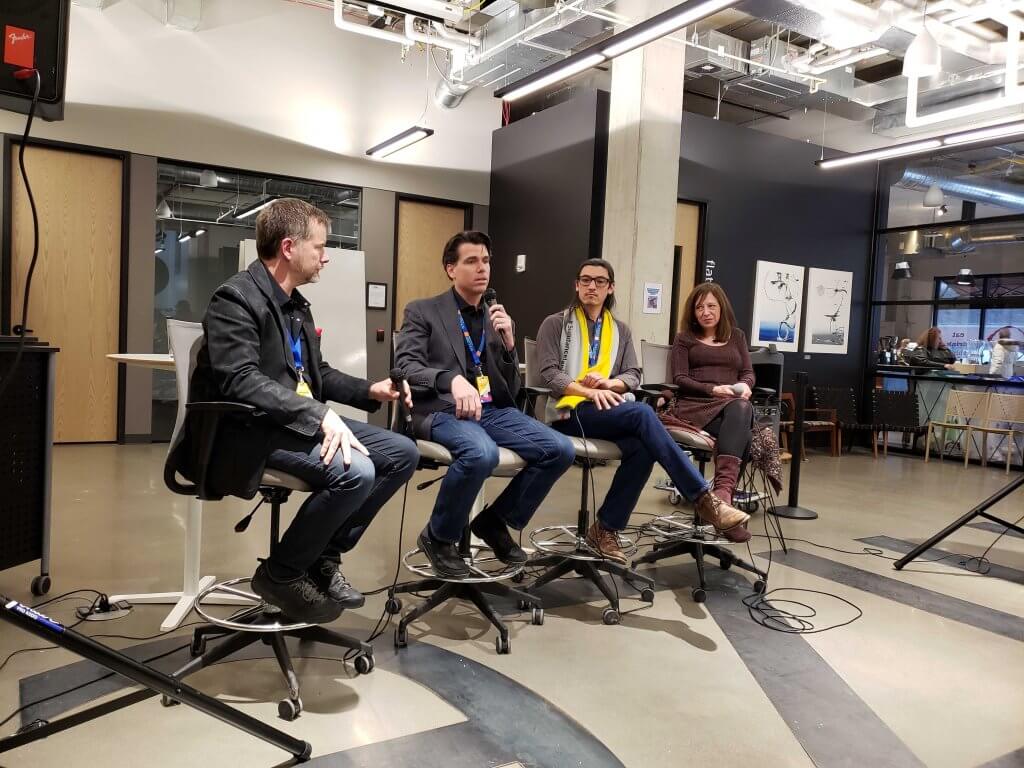Events
The Future of Extended Reality

The Boulder International Film Festival (BIFF) has become one of the most influential and innovative film festivals in the United States. It might seem strange that CableLabs, a core technology company, was invited to participate in the festival’s creative conversations about the future of narrative media. Technology and the arts have always fed off of each other, but every once in a while, a generational disruption defines a new paradigm for both of them.
XR Panel
The festival’s panel on extended reality (XR) experience was hosted by Mark Read, founder of Hypercube, and I was honored to share the stage with Jeff Orlowski, Emmy-winning filmmaker, and Brenda Lee, founder, and CEO of Reality Garage. The panel discussed XR as a term that identifies how real-and-virtual environments are combined, whether it be mostly virtual as in virtual reality (VR), or more combined as in mixed reality, and the ever-improving technologies that make immersive media environments possible and how they can be experienced.
Discussions explored current immersive technologies, such as 360VR (looking in all directions in a static position), 6 Degrees of Freedom or 6DoF (looking and moving about in all directions and positions), augmented and mixed reality (looking through glasses to see digital media interacting with physical surroundings), and light field holographic displays (looking at true 3D volumetric media without glasses), as well as artificial intelligence (AI) and how it might be used within these environments.
The Importance of Narratives
The panel dove into what’s currently working and not working with XR, especially concerning narratives. One theme, consistent across the panel, was that immersive experiences feel much more real. Seeing a lion in VR gives the user a much more tangible experience of the animal compared with viewing it on a flat screen. But the novelty of these experiences tends to be short-lived, partly because the headsets required for them are still too bulky and off-putting, but mostly because the narrative quality of today’s titles are not compelling enough to move the needle on mass consumer adoption.
Millions of people love to watch The Lion King. It doesn’t matter that the lions aren’t real, or that the audience can’t walk around a scene. The quality of the narrative experience is what consumers demand, and that quality comes from over a century of evolution of how to tell compelling visual stories in the cinematic arts.
Games are the same way: Using 6DoF to move around inside of a game is not what causes gamers to return to their favorite titles. The 6DoF experience is compelling for a little while, but for most people, the flat screen comes back after the novelty of the XR has passed.
New Paradigm
For XR today, there’s a big gap between what the technology can do versus what consumers will pay for, but it was unanimous that this is temporary. The clunky headsets, the limited environments and haptics (physical feedback), the dumb characters and dialogue are all just stepping stones toward smarter and more compelling immersive systems.
The field of XR, as a narrative craft, is in its infancy and requires a new creative paradigm to move forward. XR can be compared with the sophistication of the first film 120 years ago, when an edit had not yet been conceived, much less the use of different camera angles. In the gaming industry, XR is comparable to Atari’s Pong, before the 2-D joystick control made more innovative games possible. What set of technologies and content will move the needle of XR forward to mass consumer adoption?
This is a new era in the digital media ecosystem. Gaming was the first content evolution from passive television which led to the interactive explosion of gaming today, and now there’s another kind of experience on its way. The new paradigm of the consumer experience is moving from controlling the content to being with the content.
What CableLabs is Doing
These ideas are not science fiction: CableLabs is working with a diverse group of industry leaders to standardize the format for network delivery of immersive media. This includes developing interoperable interfaces and exchange formats that will be shared by the ecosystem of capture-and-display manufacturers, network providers and content creators. With the capacity of the 10G network, extended reality will scale to hundreds of millions of consumers across the US.
What does an XR industry ecosystem look like at mass consumer adoption? This is the question that’s getting the attention of the cable industry, and it’s why we’re working directly with creatives as well as everybody else in the ecosystem: to create the future.



